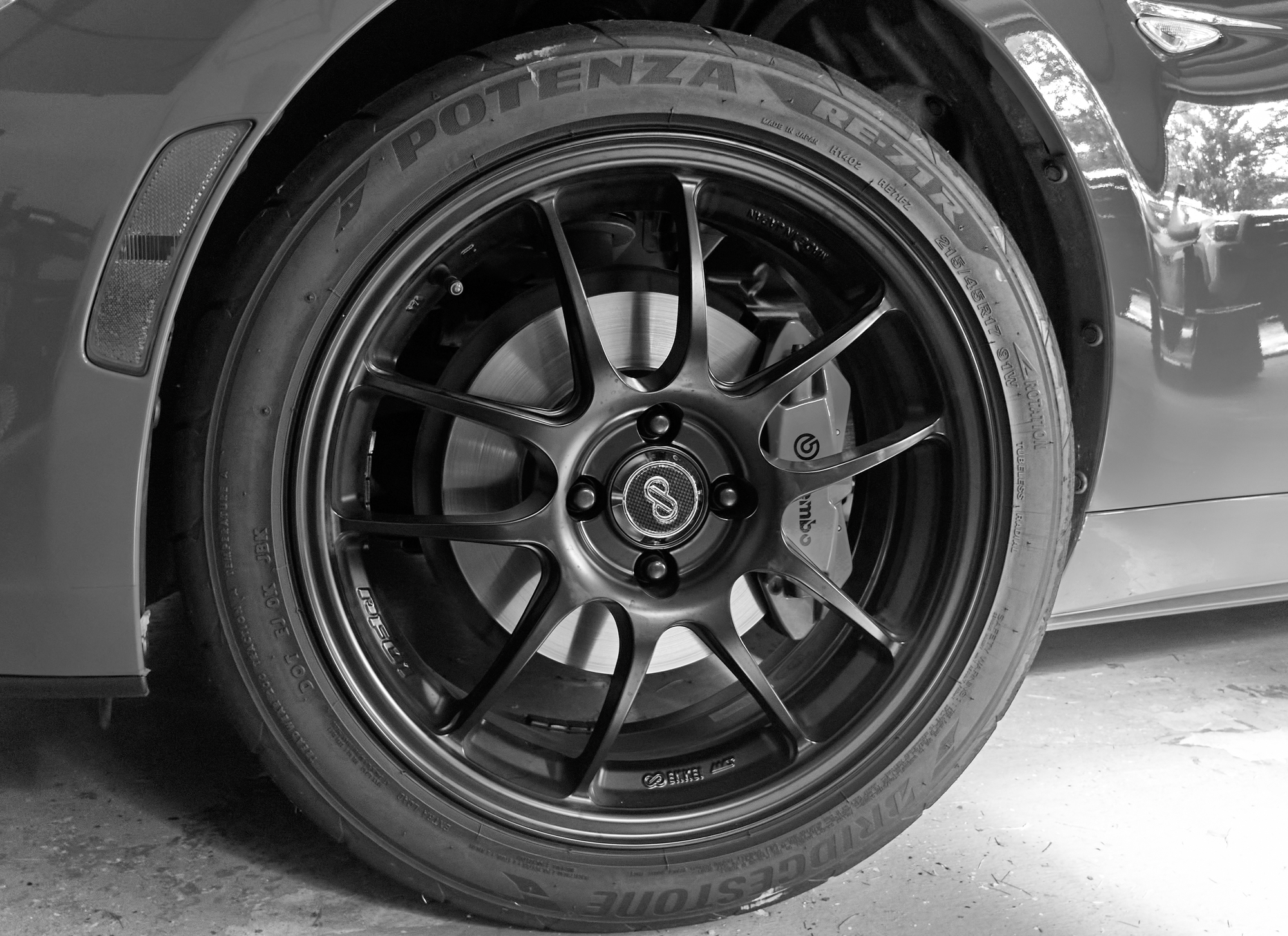For autocross, or really any other track sport, grip is a key element of performance. The simplest, yet likely the most impactful track performance improvement you can make to most mass-produced performance vehicles is upgrading your tires. Grip is, generally speaking, the thing to maximize.
The all-season tires that were fit to the MX-5 at the factory—Bridgestone Potenza S001—are pretty decent for backroads and spirited driving, but they don't cut it in competition. This is not a surprise, and not at all a knock on the Potenzas; they are a lot more durable than a soft-compound tire, have less road noise, and the softer walls make for a more comfortable ride. They also have satisfactory handling in varied weather conditions, dry or (moderately) wet, cold or warm. But for competition applications, and like everything else in motorsports, "what doesn't make you faster makes you slower."
Maximizing grip comes down to two things: tire contact patch and tire compound (yes, this is an oversimplification, but this thought framing is useful for the task at hand). The SCCA Solo rules (Solo == Autocross) restrict the compounds and sizes, among other things, that are legal for each class, and it's important to have a good understanding of what your class-specific rules are. In my case, running in C Street, the restrictions boil down to commercially available tires with a minimum UTQG (Uniform Tire Quality Grade) Treadwear number of 200—200tw, for short—in any size that will fit class-legal size wheels and not require any body or suspension changes for fitment.
The stock-size tires on an ND (4th generation) Miata are 205/45R17. On the stock 17" wheels, the widest tires that are consistently reported to fit without any rubbing are size 225/45R17. So, find a good brand of 225/45R17 tires at 200tw and problem solved, right? Not so fast.
All else being equal, a larger tire will certainly have more potential grip that a smaller one. But you may have noticed that the tire sizes above are not identical in overall diameter. Nominally the 225 size will be approximately 0.7 in. larger in diameter than the factory size. That can affect acceleration and braking distance. It will stretch gears a bit. The 225 size will also be heavier that the stock 205, by 1 lb. per tire, according to one manufacturer's specs, and this will also affect acceleration and handling.
Tire diameter also dictates the car speed at the shift points. This is important because most autocross tracks are designed to keep speeds low, usually hovering around 60 mph for the CS class. That is just about the top of 2nd gear on an ND Miata. With larger tires you might be able to avoid hitting the rev limiter at tracks that are a bit faster, or you might be slightly off the power band at tracks that are bit slower. I only have three events under my belt as I write this, all at the same venue, but my experience is that even with different layouts the track speed has been about the same. I expect this will probably be true for other clubs running events at their own favorite venues. This might be an important data point for you. In my case, I have yet to hit the red line in 2nd gear, so a larger tire would not have given me an advantage in the events I've been on.
With me, so far? Good. Let's talk about tire dynamics and performance profile, i.e., how tire performance changes in the course of an event. 200tw and softer tires will behave differently depending on tire temperature, and the performance changes will affect track time. They have a peak grip zone, outside of which they lose performance. That zone varies based on manufacturer. Some brands "activate" early, i.e., at a lower temperature, but decay with heat; some need a warmup and must be kept at temp, either with tire blankets or by employing a second driver.
Early in the selection process I identified this as the threshold of diminishing returns in my research. I knew whatever 200tw tire I got would be better than the stock tires (which are 280tw, for reference). I also knew that most of the performance gains I can make this year are very likely to come from one main source: driver improvement. I fully expected that I was going to be the limiting factor with a better tire, and the technical differences between tire brands would be close to meaningless (my first event on the new tires largely confirmed this prediction). So I cheated here. To pick a tire manufacturer I simply looked at every Miata in the paddock and peeked at what tires they had on. Last season the most common choice was, by far, Bridgestone Potenza RE-71R. And that's what I chose.
For size I picked 215/45R17 as a happy medium between grip increase and weight and diameter effects. I got the new tires mounted to a new set of spare wheels (Enkei Racing PF01), which allows me to switch between touring and autocross tires, saving the 200tw tires for autocross only and not expend them in daily driving. This was early last winter of course, before COVID-19 changed everything and made the concept of "daily driving" seem like a quaint relic of a distant past.
Was It Worth It?
You bet! Let's compare my two events last year on stock tires, to the one event this year, on the RE-71Rs:
- BMC 2019 Autocross III (September 2019): 55th out of 85 PAX, and 7th out of 9 in class (official results).
- BMC 2019 Autocross IV (October 2019): 54th out of 90 PAX, and 3rd out of 4 in class (official results).
- BMC 2020 Autocross I (July 2020): 18th out of 74 PAX, and 1st out of 2 in class (official results).
Not enough data points to draw statistically significant conclusions, you might say. Well, this ain't "racing by the seat of my pants" for nothing. If you extrapolate these three samples a wee bit there's a distinct improvement in my performance relative to the field after installing the new more competitive tires. The class data is a bit thin, but the PAX-adjusted scoring shows a progression from 35th-40th percentile last season, to 75th percentile this season.
So yeah, worth it. I plan to do at least a couple more events before touching anything else in the car, to get a good baseline on the new setup. The next planned "upgrade" is a more aggressive alignment, a much more trial-and-error driven process than tire selection, and it will be interesting to see what that can do for my times.


